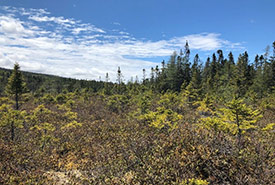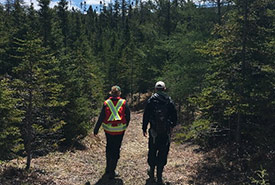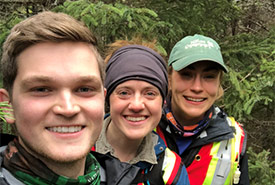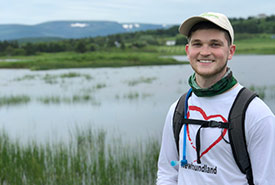The Nature Conservancy of Canada Conservation Internship: Not your average summer

Open woodland located on the Barachois Brook property (Photo by NCC)
When I started my internship with the Nature Conservancy of Canada (NCC) in St. John’s, Newfoundland and Labrador, in May 2018, I knew that one of my responsibilities would be to complete a baseline inventory of the newly established Barachois Brook Nature Reserve. A baseline inventory is a comprehensive survey of species, ecosystems and any human features on an area. The inventory is used as part of NCC’s Property Management Plan. This new nature reserve is 195 acres (78 hectares) of boreal forest bordering Barachois Pond Provincial Park, one of Newfoundland’s most popular parks.
After a few short weeks in the office, the time came to pack up and make the eight-hour drive to the west coast. Based on what I had learned about the property, I had some idea of what to expect on the landscape. What I didn’t expect, however, was that conducting a baseline inventory for NCC would provide me with an outstanding wealth of knowledge and amazing friendships that will last a lifetime.

Megan Lafferty (left) and Matthew Anstey (right) discussing bird identification (Photo by NCC)
In between battling the spruce and alder thickets, my colleagues, Megan Lafferty and Julia Lawler (NCC’s Newfoundland and Labrador team), identified various species located on the property. I am fairly confident with plant identification, but I am less familiar with birds — and there are many different types of birds in this nature reserve! Luckily, Megan and Julia were there to help.
Personally, I find it easier to identify birds by listening for their distinct call rather than observing them. With the help of mnemonics, we identified ruby-crowned kinglets, boreal chickadees and 10 other species of birds. Even though we were on a tight schedule, Megan and Julia still encouraged me to pause for a moment, turning a work assignment into an educational experience.
After a long day of field work, my favourite part was sharing a conversation while making an amazing dinner to replenish and refuel our energy. With three of us in the kitchen, the meal prep took no time, and before we knew it we were eating a fresh, delicious dinner. By the time the dishes were done, we were all so tired that we plopped down on the couches to relax. Shortly after, we all headed to bed to get a good night’s sleep for another intense day of field work.

Matthew Anstey (left), Julia Lawler (centre) and Megan Lafferty (right) conducting an Atlantic ecosystem classification on the Barachois Brook property. (Photo by NCC)
If you had asked me at the beginning of my internship to list what I would gain from this experience, I would probably not have included friendship. Working closely with two like-minded people, who just so happen to be your supervisors, allowed me to bond with Megan and Julia in a way that I never thought possible.
Even though we were in close quarters for 10 days, we never got tired of one another. In fact, as time passed, we realized that we share many similar passions. Julia and I couldn’t stop talking about the cultural significance of Netflix’s new hit series Queer Eye. Megan and I shared our love for restoration and the outdoors as we planted the last of 1,500 seedlings during our June Conservation Volunteers event on the Crabbes River Nature Reserve.
It is incredible that one internship over the course of a few months can provide such a wealth of knowledge and life-changing experiences. I know I will draw on this experience in the years ahead, especially during my upcoming master’s program in environmental science at the University of Toronto. If you’re looking to build a diverse and practical conservation skill set, I highly recommend NCC’s Conservation Internship Program!
The Conservation Internship Program is funded in part by the Government of Canada’s Summer Work Experience program. Husky Energy is also a generous supporter of the Conservation Internship Program in Newfoundland and Labrador.


